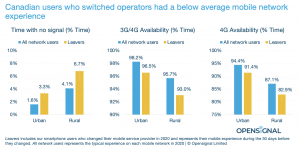Missing the point
The following opinion piece appeared on Friday on National Newswatch.
Interestingly, a paper in Telecom Policy by Mark Jamison and Peter Wang of the University of Florida came to my attention on Friday. The study found that there was a five-fold increase in consumers valuation of digital services during the coronavirus outbreak. This struck me as relevant to my opinion piece, below.
I was struck by a recent editorial in the Globe and Mail (“Two years ago, Ottawa aimed to lower the high price of wireless and internet. Not any more”). It seemed to get many of the background facts right, but somehow didn’t follow its own logic to reach its conclusion.
Let’s look at their own words:
In the span of just two years, Ottawa has completely reversed its thinking – from worrying about the impact of high prices on Canadians, to worrying about the impact that lower prices would have on big telco capital spending.
Gee. What could have happened in the past two years that might have led policy makers to rethink their priorities? What changed?
Let’s see if the Globe and Mail has the answer:
Capital investment in the latest and best networks is necessary. The pandemic made clear a good internet connection is vital to the modern economy.
It is also true that while 99 per cent of urban households are reached by a pipe carrying fast and unlimited internet, that’s only true of 46 per cent of rural households, according to the CRTC. The latter figure is rising but is still too low.
Prices came down, meeting the government’s targets and prices are still falling. But that pandemic accentuated the fact that too few households in rural Canada have access to fast unlimited internet. And government broadband funds just aren’t moving the needle fast enough as I recently remarked. The Rapid Response Stream simply isn’t rapid enough.
The need for capital investment in networks became more evident, for expanding service to unserved areas, as well as enhancing service in all areas.
As the Globe itself recognized, “a careful balance is necessary, when it comes to the wholesale rates charged to upstarts for network access.”
Increased investment from facilities-based carriers, and that includes major companies and smaller regional and local companies, means expanded coverage for rural Canadians, reducing the need for government subsidies for broadband builds and accelerating service delivery.
Are there still affordability challenges for some Canadians? Absolutely. There are many factors inhibiting broadband adoption in low-income households. But those problems don’t get solved by arbitrarily lowering prices. Studies have shown “the price of broadband service is not the primary factor that keeps many low-income households from subscribing.”
Lower wholesale rates won’t lead to increased adoption of broadband services among low income households, but such regulatory rate action clearly harms the business case for carriers to expand their service areas.
So, let’s recap. The Globe editorial noted that “In the span of just two years, Ottawa has completely reversed its thinking.”
What happened in the past two years?
The pandemic helped all of us gain a greater appreciation for the necessity of broadband and the urgency for increasing capital investment in telecommunications infrastructure. Ottawa looked at the facts and, “Acting in the public interest”, recognized the landscape had changed.
The CRTC reviewed its 2019 decision and found that it made material errors that were harming the business case for broadband investment. It needed to correct its error.
As Minister Bains said last August “Canada’s future depends on connectivity”.

